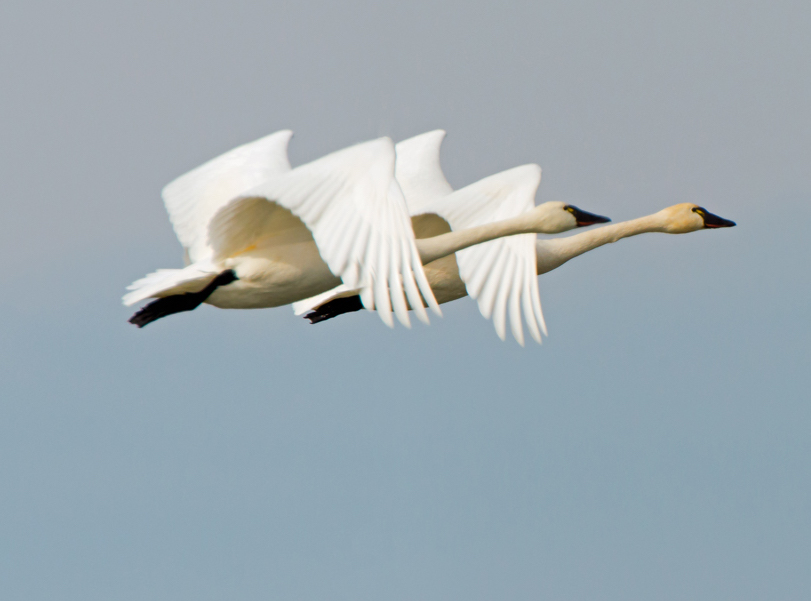The conclusion of a three-part series. Read Part 1 and Part 2 to catch up.
With our research on hunting techniques, preparing a swan for the table, and a successful draw, we counted down the days for our chance to harvest the largest member of the waterfowl family.
On the morning of our hunt, Troy sent a picture of his own swan he’d taken just hours earlier.
Henry was anxious.
“Why didn’t we go in the morning instead of the afternoon???”
Because of school, we’d opted to let Henry get in at least half a day of class before heading out for the hunt. Now he was worried lighting wouldn’t strike twice in the same day.
After what seemed like an eternity, we were finally loaded up and ready to go. Troy pointed the bow of his boat west, and we finally motored out under the sunny skies of Harold Crane Waterfowl Management Area. It was cold but not terribly so, especially for December. Enough wind to hopefully keep birds moving.
We were soon buried in the reeds 100 yards from where Troy had connected earlier in the day. Three dozen mixed decoys bobbed in the reflection of the snow-capped Wasatch Range, presided over by six large, white swan imitations. Pintails, gaddies, mallards, and spoonies crossed regularly, but only one group swung into the decoys. Three didn’t leave.
But . . . no swans.
Soon, though, the haunting cries of the birds filled the marsh and became constant. Strings and vees of the brilliant white birds shone in the blue winter sky. Henry’s anticipation was palpable.
A small group of specks began to grow larger in the distance, their mournful cries growing ever louder. Swans were headed our way.
Hearts beat quicker as we tucked our heads down, not wanting to ruin this chance. Two birds continued toward us as the others angled off. In just a few seconds the duo was looking over our decoys.
“Are they close enough?!” Henry whispered excitedly.
“Looks like,” Troy growled.
I was less sure.
“Too far. Give them one more pass and they’ll swing in,” I advised.
The birds just kept flying. Henry gave me that, “Really, Dad?” look. He began doubting whether he’d get another chance.
“I should’ve taken the shot!” he muttered.
“We’ll get better shots, trust me,” Troy counseled him. With the number of swans in the air, I knew Troy was right.
Twenty minutes later, after numerous anxious moments, four big birds, enticed by their “comrades” on the water, turned towards our spread.
“Here they come. Get ready,” whispered Troy.
The birds pressed closer. Soon they were losing altitude and dropping their feet to slow down.
“Okay, safety off,” was answered with a click. Four snowy adults and one gray juvenile paralleled the edge of the decoys in front of us and banked hard, curving behind the boat.
“Take ’em, Henry,” called Troy.
In one smooth motion, Henry turned back over his left shoulder and swung through as the birds set their wings to continue their circle and drop in. His Remington 870 barked, and Henry racked for follow-up shots. None were needed.

Henry with his first tundra swan. (Photo: Alan Peterson)
The trailing juvenile’s head flew back, wings thrown up—clean kill, perfect shot. Down it plummeted into the cattails.
“I got ’im!” Henry yelled.
Troy’s big laugh boomed out over the marsh.
“Well, that was quick! Nice shot!” He shook his head in disbelief. “Doesn’t happen like that very often.”
“Doesn’t get better than that. One shot!” I exclaimed, giving Henry a bear hug. Henry’s smile won’t soon be forgotten. Clicking his gun back on safe, he followed Troy out into the water. He emerged from the brown cattails a few moments later with an even bigger smile—and a bird even bigger than that. We spent the next several moments admiring the bird and reliving the event.
Dustin was so right: “Everybody should try it at least once. If you find yourself with a tag and no experience, ask. There are enough good people in the waterfowl hunting world; someone will take you.”
Swans make for an unusual hunt in spectacular locations. It requires commitment in time and energy but holds a great payoff.
I’m reaching the age where it’s easier and easier to find greater satisfaction in seeing my son’s success than in my own. Standing in the warm evening glow as the sun set, appreciative of Troy’s expertise and friendship, feeling Henry’s pleasure in a job well done, it was hard to imagine it being any better if I had drawn a tag myself. I know, like my father before me, I’ll be talking about my son’s shot for a long time to come . . .
. . . along with the pastrami.

